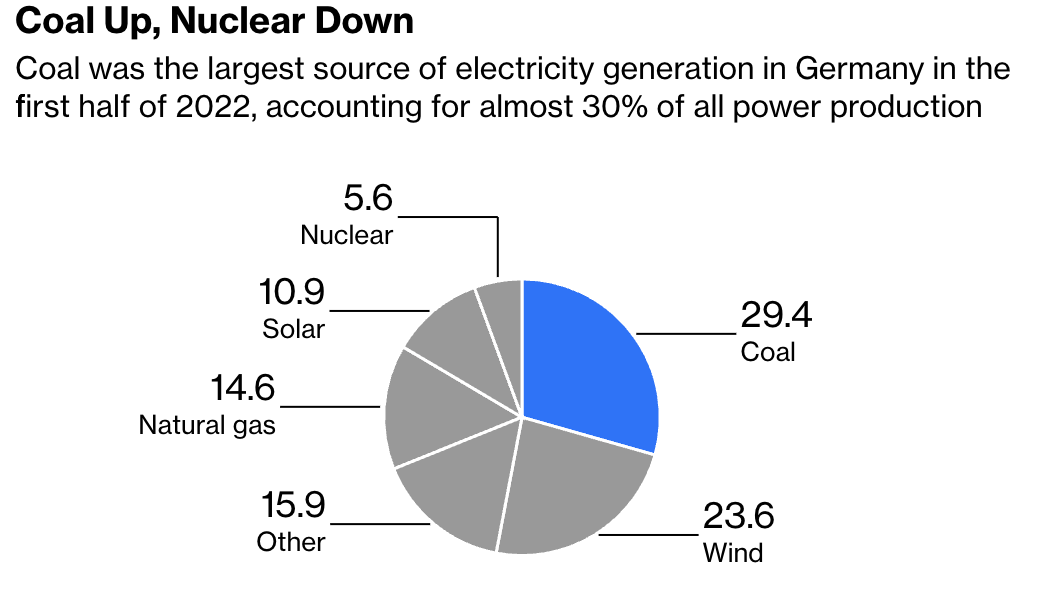Europe’s energy system is a mess due to its headlong sprint into renewable energy (mostly intermittent wind and solar power), the shuttering of coal and nuclear plants, its banning of hydraulic fracturing, and its cutoff of offshore oil and gas leases. Due to astronomical natural gas prices, Europe is shuttering factories and industries and furloughing employees. Germany’s producer prices of industrial products increased by 45.8 percent in August based on the same month last year. Now, Europe is begging to buy coal—a fuel it shunned–at premium prices. Buyers in Europe are paying top dollar for coal from often remote mines in Tanzania, Botswana and potentially Madagascar. These purchases clash with European climate plans to shift away from coal. In Germany, coal was the largest source of electricity generation in the first half of 2022, producing 29.4 percent of its power.

Unfortunately, President Biden is implementing anti-fossil fuel policies much like those in Europe, which could end up having similar results. Biden, like Europe, wants to blame high energy prices on Russia’s invasion of Ukraine. However, Europe started having energy supply problems immediately after the COVID lockdowns ended and demand picked up, depleting its stocks of natural gas. Adding to the situation were low wind resources so wind turbines were producing less power and more natural gas was used for power generation.
Energy prices in Europe are so high that the British government is capping average household energy bills at around 2,500 pounds ($2,868) a year for two years, costing the country upwards of 100 billion pounds ($115 billion). It is also capping wholesale electricity and gas costs for businesses at less than half the market rate beginning in October, which will also add tens of billions of pounds to the government’s spending spree. More than 20 British power providers have gone under–many because a government price cap prevented them from passing the soaring prices onto households. Germany is nationalizing Uniper, the country’s largest gas importer, at a cost of $28.7 billion and is considering providing financial support to regional state-owned energy providers. France is allocating 9.7 billion euros ($9.1 billion) to take full control of utility EDF.
Coal Prices and Trade Flows
The European Union’s ban on Russian coal imports has increased pressure on electricity generators to find alternative sources of fuel. Russia had provided about 70 percent of the EU’s thermal coal before the ban. Australia, a major coal producer, shipped 2.9 million metric tons of coal to Europe through July of this year, 73 percent more than the entire 2021 year. Front-month thermal coal at Australia’s Newcastle port – a global benchmark – traded at $429 a metric ton on September 16, just below an all-time high of $483.50 in March and up from around $176 per metric ton last year.
Since November of last year, when Mtwara, the port in Tanzania, launched its first coal shipment, the port has loaded 13 vessels with coal trucked 600 kilometers from mines in the Southwest. Recently, a bulk carrier with a 34,529-metric-ton capacity sailed from the port to France loaded with coal. Since the end of June, 57 cargo orders for available vessels to ship Tanzanian coal have been seen on the spot freight market compared with just two in the same period last year. Tanzania expects coal exports to double this year to 696,773 metric tons, and its coal production to increase by 50 percent to 1,364,707 metric tons. Tanzania-based miner Ruvuma Coal exported coal to the Netherlands, France and India since November. Prior to the escalating prices, Tanzania only exported coal to neighboring countries.
Global seaborne thermal coal imports reached 97.8 million metric tons in July, the highest level on record and up more than 9 percent year-on-year. The volume dropped to 89 million metric tons in August, largely due to export disruptions from Australia.
Conclusion
The energy situation in Europe is dire. Europe’s energy crisis has left few businesses untouched, including steel, aluminum, automobile, glass, ceramics, sugar, and toilet paper makers. Some industries, such as the energy-intensive metals sector, are shutting factories that may never reopen, resulting in thousands of job losses. The growing energy crisis created originally by the underperformance of renewable energy was exacerbated by the Russian invasion of Ukraine resulting in Russia’s closure of the Nord Stream 1 pipeline due to sanctions imposed by the West. The UK has capped energy prices for households and businesses, countries are taking over energy firms, and the European Union is taxing energy producers that have profits from the soaring prices.
But the high prices are caused by energy shortages, and Europe is looking for enough energy supplies to get through the winter. Despite their climate pledges to the Paris Accord, European countries are turning to coal and seaborne shipments are reaching records. Coal prices at Australia’s hub are more than double what they traded at last year. Despite the interest in coal and energy survival in Europe, here in the United States, President Biden is pushing on with his anti-fossil fuel and pro-climate stance. He is learning nothing from Europe’s energy predicament.